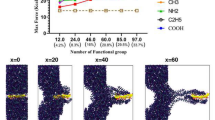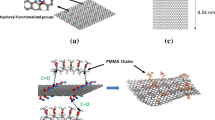Abstract
Molecular dynamics simulations are used to investigate the effect of graphene dispersion on the equilibrium structure and deformation of graphene/eicosane composites. Two graphene sheets with four different interlayer distances are incorporated, respectively, into a eicosane matrix to form graphene/eicosane composites representing different graphene dispersions. With greater graphene dispersion, the “adsorption solidification” of the eicosane increases, where eicosane molecular lamination, orientation, and extension become more uniform and stronger. In addition, eicosane molecular motion is inhibited more in the direction perpendicular to graphene surfaces. When these graphene/eicosane composites are deformed, the free volume initially increases slowly due to small, scattered voids. After reaching the yield strains, the free volume rises sharply as the structures of composites are damaged, and small voids merge into large voids. The damage always occurs in the region of the composite with the weakest “adsorption solidification.” Since this effect is stronger when the graphene sheets are more dispersed, more complete dispersion results in higher composite yield stresses. Lessons from these simulations may provide some insights into graphene/polyethylene composites, where suitable models would require very long equilibration times.












Similar content being viewed by others
Notes
Accelrys, Inc. http://accelrys.com/products/materials-studio/ (date accessed: January 12, 2011).
References
Novoselov KS, Geim AK, Morozov SV, Jiang D, Zhang Y, Dubonos SV, Grigorieva IV, Firsov AA (2004) Electric field effect in atomically thin carbon films. Science 306:666–669
Lee C, Wei X, Kysar JW, Hone J (2008) Measurement of the elastic properties and intrinsic strength of monolayer graphene. Science 321:385–388
Du X, Skachko I, Barker A, Andrei EY (2008) Approaching ballistic transport in suspended graphene. Nat Nanotechnol 3:491–495
Georgakilas V, Otyepka M, Bourlinos AB, Chandra V, Kim N, Kemp KC, Hobza P, Zboril R, Kim KS (2012) Functionalization of graphene: covalent and non-covalent approaches, derivatives and applications. Chem Rev 112:6156–6214
Mittal G, Dhand V, Rhee KY, Park S-J, Lee WR (2015) A review on carbon nanotubes and graphene as fillers in reinforced polymer nanocomposites. J Ind Eng Chem 21:11–25
Huang X, Qi X, Boey F, Zhang H (2012) Graphene-based composites. Nature 41:666–686
Kuilla T, Bhadra S, Yao DH, Kim NH, Bose S, Lee JH (2010) Recent advances in graphene based polymer composites. Prog Polym Sci 35:1350–1375
Singh V, Joung D, Zhai L, Das S, Khondaker SI, Seal S (2011) Graphene based materials: past, present and future. Prog Mater Sci 56:1178–1271
Hu K, Kulkarni DD, Choi I, Tsukruk VV (2014) Graphene-polymer nanocomposites for structural and functional applications. Prog Polym Sci 39:1934–1972
Zhao X, Zhang Q, Chen D, Lu P (2010) Enhanced mechanical properties of graphene-based poly(vinyl alcohol) composites. Macromolecules 43:2357–2363
Liang JJ, Wang Y, Huang Y, Ma YF, Liu ZF, Cai JM, Zhang CD, Gao HJ, Chen YS (2009) Electromagnetic interference shielding of graphene/epoxy composites. Carbon 47:922–925
Pang HA, Chen C, Zhang YC, Ren PG, Yan DX, Li ZM (2011) The effect of electric field, annealing temperature and filler loading on the percolation threshold of polystyrene containing carbon nanotubes and graphene nanosheets. Carbon 49:1980–1988
Song PG, Gao ZH, Cai YZ, Zhao LP, Fang ZP, Fu SY (2011) Fabrication of exfoliated graphene-based polypropylene nanocomposites with enhanced mechanical and thermal properties. Polymer 52:4001–4010
Rafiee MA, Rafiee J, Srivastava I, Wang Z, Song H, Yu Z-Z, Koratkar N (2010) Fracture and fatigue in graphene nanocomposites. Small 6:179–183
Ramanathan T, Abdala AA, Stankovich S, Dikin DA, Herrera-Alonso M, Piner RD et al (2008) Functionalized graphene sheets for polymer nanocomposites. Nat Nanotechnol 3:327–331
Si Y, Samulski ET (2008) Synthesis of water soluble graphene. Nano Lett 8:1679–1682
Si Y, Samulski ET (2008) Exfoliated graphene separated by platinum nanoparticles. Chem Mater 20:6792–6797
Zacharia R, Ulbricht H, Hertel T (2004) Interlayer cohesive energy of graphite from thermal desorption of polyaromatic hydrocarbons. Phys Rev B 69:155406
Tang LC, Wan YJ, Yan D, Pei YB, Zhao L, Li YB, Wu LB, Jiang JX, Lai GQ (2013) The effect of graphene/epoxy composites on the mechanical properties of graphene/epoxy composites. Carbon 60:16–27
Kim H, Miura Y, Macosko CW (2010) Graphene/polyurethane nanocomposites for improved gas barrier and electrical conductivity. Chem Mater 22:3441–3450
Yang SY, Lin WN, Huang YL, Tien HW, Wang JY, Ma CCM, Li SML, Wang YS (2011) Synergetic effects of graphene platelets and carbon nanotubes on the mechanical and thermal properties of epoxy composites. Carbon 49:793–803
Montazeria A, Rafii-Tabar H (2011) Multiscale modeling of graphene- and nanotube-based reinforced polymer nanocomposites. Phys Lett A 375:4034–4040
Ebrahimi S, Ghafoori-Tabrizi K, Rafii-Tabar H (2012) Multi-scale computational modelling of the mechanical behaviour of the chitosan biological polymer embedded with graphene and carbon nanotube. Comput Mater Sci 53:347–353
Zhang T, Xue Q, Zhang S, Dong M (2012) Theoretical approaches to graphene and graphene-based materials. Nano Today 7:180–200
Shiu SC, Tsai JL (2014) Characterizing thermal and mechanical properties of graphene/epoxy nanocomposites. Compos B 56:691–697
Rahman R, Haque A (2013) Molecular modeling of cross-linked graphene–epoxy nanocomposites for characterization of elastic constants and interfacial properties. Compos B 54:353–364
Rahman R, Foster JT (2014) Defromation mechanism of graphene in amporphous polyethylene: a molecular dynamics based study. Comput Mater Sci 87:232–240
Hadden CM, Klimek-McDonald DR, Pineda EJ, King JA, Reichanadter AM, Miskioglu I, Gowtham S, Odegard GM (2015) Mechanical properties of graphene nanoplatelet/carbon fiber/epoxy hybrid composites: multiscale modeling and experiments. Carbon 95:100–112
Lv C, Xue Q, Xia D, Ma M, Xie J, Chen H (2010) Effect of chemisorption on the interfacial bonding characteristics of graphene–polymer composites. J Phys Chem C 114:6588–6594
Lv C, Xue Q, Xia D, Ma M (2012) Effect of chemisorption structure on the interfacial bonding characteristics of graphene–polymer composites. Appl Surf Sci 258:2077–2082
Xiong QL, Tian XG (2015) Atomistic modeling of mechanical characteristics of CNT-polyethylene with interfacial covalent interaction. Journal of Nanomaterials 1-9
Liu F, Hu N, Ning H, Liu Y, Li Y, Wu L (2015) Molecular dynamics simulation on interfacial mechanical properties of polymer nanocomposites with wrinkled graphene. Comput Mater Sci 108:160–167
Rissanou AN, Power AJ, Harmandaris V (2015) Structural and dynamical properties of polyethylene/graphene nanocomposites through molecular dynamics simulations. Polymer 7:390–417
Rissanou AN, Harmandaries V (2014) Dynamics of various polymer–graphene interfacial systems through atomistic molecular dynamics simulations. Soft Matter 10:2876–2888
Plimpton S (1995) Fast parallel algorithms for short-range molecular dynamics. J Comput Phys 117:1–19
Sun H (1994) Force field for computation of conformational energies, structures, and vibrational frequencies of aromatic polyesters. J Comput Chem 15:752–768
Yang S, Yu S, Cho M (2013) Influence of Thrower–Stone–Wales defects on the interfacial properties of carbon nanotube/polypropylene composites by a molecular dynamics approach. Carbon 55:133–143
Fan HB, Yuen MMF (2007) Material properties of cross-linked epoxy resin compound predicted by molecular dynamics simulation. Polymer 48:2174–2178
Yang L, Srolovitz DJ, Yee AF (1997) Extended ensemble molecular dynamics method for constant strain rate uniaxial deformation of polymer systems. J Chem Phys 107:4396–4407
Hossain D, Tschopp MA, Ward DK, Bouvard JL, Wang P, Horstemeyer MF (2010) Molecular dynamics simulations of deformation mechanisms of amorphous polyethylene. Polymer 51:6071–6083
Jiang Q, Tallury SS, Qiu YP, Pasquinelli MA (2014) Molecular dynamics simulations of the effect of the volume fraction on unidirectional polyimide–carbon nanotube nanocomposites. Carbon 67:440–448
Edelsbrummer H, Mücke EP (1994) Three-dimensional alpha shapes. ACM Trans Graph 13:63–100
Stukowski A (2014) Computational analysis methods in atomistic modeling of crystals. JOM 66:399–407
Stukowski A (2010) Visualization and analysis of atomistic simulation data with OVITO—the Open Visualization Tool. Model Simul Mater Sci Eng 18:015012
Chen SH, Sun SQ, Gwaltney SR, Li CL, Wang XM, Hu SQ (2015) Molecular dynamics simulations of the interaction between carbon nanofiber and epoxy resin monomers. Acta Polym Sin 10:1158–1164
Nouranian S, Jang C, Lacy TE, Gwaltney SR, Toghiani H, Pittman CU Jr (2011) Molecular dynamics simulations of vinyl ester resin monomer interactions with a pristine vapor–grown carbon nanofiber and their implications for composite interphase formation. Carbon 49:3219–3232
Jang C, Nouranian S, Lacy TE, Gwaltney SR, Toghiani H, Pittman CU Jr (2012) Molecular dynamics simulations of oxidized vapor–grown carbon nanofiber surface interactions with vinyl ester resin monomers. Carbon 50:748–760
Acknowledgements
This work is supported by the National Natural Science Foundation of China (51501226 and 51201183) and the Fundamental Research Funds for the Central Universities (15CX08009A, 15CX02066A and 14CX02221A). Shenghui Chen wishes to thank Dr. Thomas E. Lacy (Mississippi State University) for the helpful discussions with him.
Author information
Authors and Affiliations
Corresponding authors
Ethics declarations
Conflict of interest
The authors declare that they have no conflict of interest.
Rights and permissions
About this article
Cite this article
Chen, S., Lv, Q., Wang, Z. et al. Effect of graphene dispersion on the equilibrium structure and deformation of graphene/eicosane composites as surrogates for graphene/polyethylene composites: a molecular dynamics simulation. J Mater Sci 52, 5672–5685 (2017). https://doi.org/10.1007/s10853-017-0802-6
Received:
Accepted:
Published:
Issue Date:
DOI: https://doi.org/10.1007/s10853-017-0802-6




